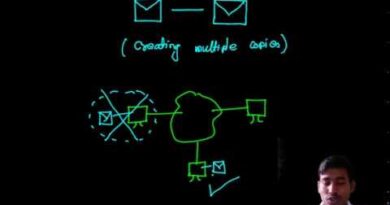Naming and Location transparency in Distributed Computing System and Distributed Database System
Naming and Location transparency in Distributed Computing System and Distributed Database System.
Contents
- 0.0.1 Naming and Location Transparency in Distributed Systems
- 0.0.2 1. Naming Transparency
- 0.0.3 In Distributed Computing Systems (DCS):
- 0.0.4 In Distributed Database Systems (DDBS):
- 0.0.5 2. Location Transparency
- 0.0.6 In Distributed Computing Systems (DCS):
- 0.0.7 In Distributed Database Systems (DDBS):
- 0.0.8 Key Differences and Similarities
- 0.0.9 Naming and Location transparency in Distributed Computing System and Distributed Database System
- 0.0.10 An Impression of Transparency in Distributed Database …
- 0.0.11 4.1 Distributed file Systems: Introduction
- 1 📌 1. What Is Naming and Location Transparency?
- 2 ⚙️ In Distributed Computing System (DCS)
- 3 🗃️ In Distributed Database System (DDBS)
Naming and Location Transparency in Distributed Systems
In Distributed Computing Systems (DCS) and Distributed Database Systems (DDBS), naming and location transparency play a crucial role in ensuring seamless access to resources and data without requiring users to know their physical locations.
1. Naming Transparency
Naming transparency ensures that users and applications can refer to resources (e.g., files, processes, services, or database records) using a consistent logical name rather than their physical location.
In Distributed Computing Systems (DCS):
- Uniform Naming: A resource should have a consistent name across the system, regardless of where it resides.
- Name Resolution: The system should translate logical names into physical addresses dynamically.
- Examples:
- DNS (Domain Name System) in the internet, which maps domain names (e.g., google.com) to IP addresses.
- Middleware systems that resolve service names to machine addresses.
In Distributed Database Systems (DDBS):
- Data items or relations (tables) are accessed using logical names instead of specific locations.
- Global Schema: Users query a global schema without needing to know where the data is stored physically.
- Example: A distributed SQL database where users query a table without knowing which server stores it.
2. Location Transparency
Location transparency ensures that users or applications do not need to know where a resource or data is physically located in the distributed system.
In Distributed Computing Systems (DCS):
- Remote and local resources appear the same (e.g., remote file systems like NFS, cloud storage).
- Load balancing and replication can move resources dynamically without affecting access.
- Example: Cloud-based applications (e.g., Google Drive) where files can be stored across multiple data centers, but users access them seamlessly.
In Distributed Database Systems (DDBS):
- Users can query a database without knowing the location of records.
- Data fragmentation and replication can be managed dynamically.
- Example: In a distributed SQL database like Google Spanner, a user query fetches records from multiple locations transparently.
Key Differences and Similarities
| Feature | Distributed Computing System (DCS) | Distributed Database System (DDBS) |
|---|---|---|
| Naming Transparency | Resources (services, files) are named logically. | Data (tables, records) are named logically. |
| Location Transparency | Users access resources without knowing their location. | Users query databases without knowing where the data is stored. |
| Example | Cloud services (AWS, Google Drive) | Distributed databases (Google Spanner, MongoDB Sharding) |
Would you like a deeper explanation of a specific aspect?
Naming and Location transparency in Distributed Computing System and Distributed Database System
An Impression of Transparency in Distributed Database …
4.1 Distributed file Systems: Introduction
Great question! Let’s break down Naming Transparency and Location Transparency in the context of both Distributed Computing Systems (DCS) and Distributed Database Systems (DDBS) — two fundamental concepts that help hide complexity from users and developers.
📌 1. What Is Naming and Location Transparency?
| Term | Definition |
|---|---|
| Naming Transparency | Users refer to resources using names, without needing to know their physical location. |
| Location Transparency | Users access resources without knowing (or caring) where the resource is actually located. |
In simple terms:
🧑💻 You can use or access something without knowing where it is or how it’s identified internally.
⚙️ In Distributed Computing System (DCS)
✅ Naming Transparency
- A user or application can call a function, access a file, or invoke a service without knowing which machine it is running on.
- Example: Accessing
\\shared\project\data.txt— user doesn’t need to know which server holdsdata.txt.
✅ Location Transparency
- The actual location of the resource (like a file, process, printer) is hidden.
- If a program uses a service on
192.168.1.100, but it gets moved to another node, the system ensures the program doesn’t break.
📌 Importance:
- Simplifies user interface
- Enhances scalability and fault tolerance
- Supports load balancing, replication, and failover
🗃️ In Distributed Database System (DDBS)
✅ Naming Transparency
- All parts of a distributed database can be accessed using a single logical name.
- Example: A table
Studentcan exist on multiple servers but is referred to asStudenteverywhere.
✅ Location Transparency
- Users query data without knowing where it physically resides.
- Example:
SELECT * FROM Employee WHERE EmpID = 1001;
This will return data whether it’s stored in New York, London, or a cloud node.
📌 Importance:
- Makes distributed DBMS appear as one unified database
- Supports data fragmentation, replication, and horizontal scaling
🧠 Why It Matters (for Both DCS & DDBS)
| Feature | Advantage |
|---|---|
| Naming Transparency | Easy access and consistent naming |
| Location Transparency | Seamless user experience |
| Both Combined | Flexibility, maintainability, fault tolerance |
✅ Quick Summary Table
| Aspect | Distributed Computing System | Distributed Database System |
|---|---|---|
| Naming Transparency | Access services/files via logical names | Access tables/data via unified names |
| Location Transparency | Use resources regardless of machine location | Query data regardless of physical location |
| Goal | Hide resource distribution | Hide data distribution |
Would you like diagrams or examples of how DNS or middleware like CORBA or RMI provide transparency?
I can also give exam-ready short notes or a PPT slide version if you’re preparing for presentations or GATE/NET exams.



